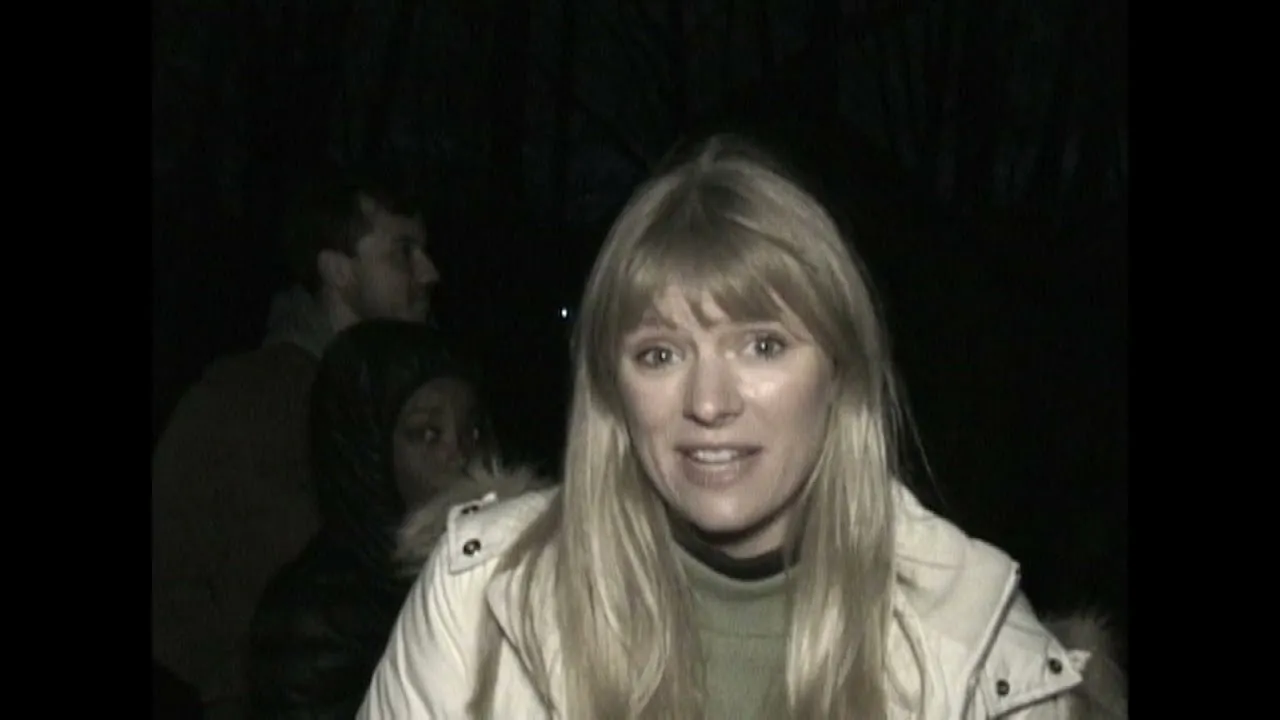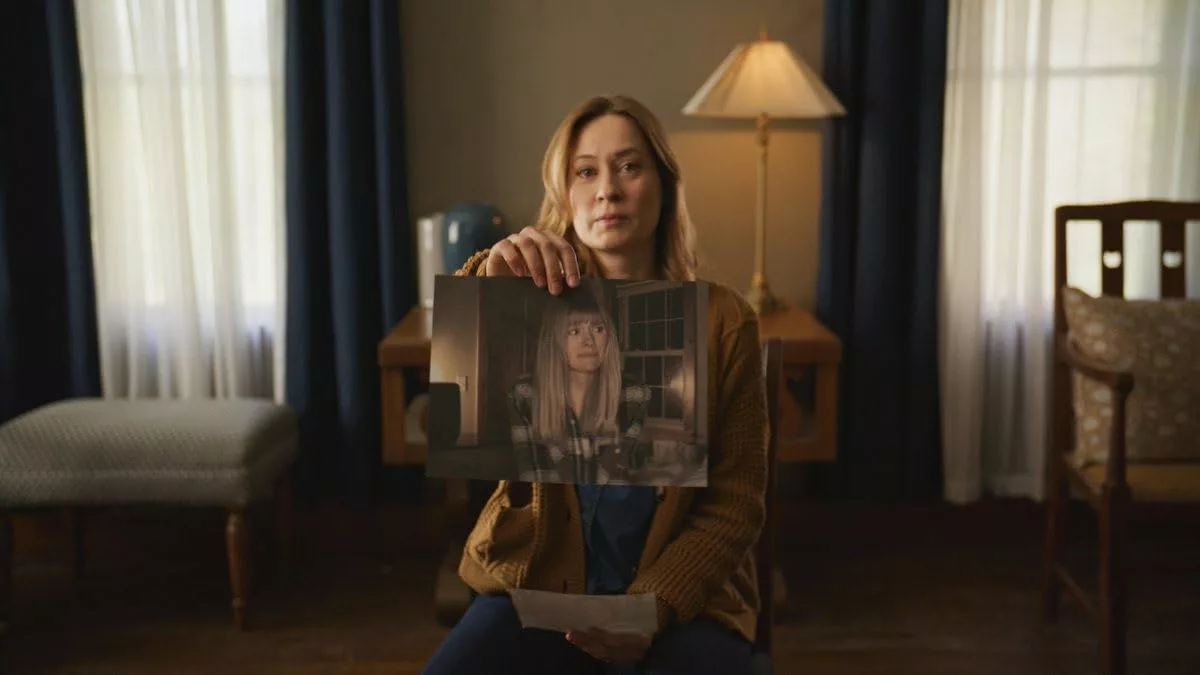Chris Stuckmann’s first feature film, Shelby Oaks tells the story of Mia, a woman who refuses to give up searching for her missing sister Riley. Over a decade ago, Riley and her ghost-hunting YouTube group, the Paranormal Paranoids, vanished without a trace in the abandoned town of Shelby Oaks, Ohio. Now Mia works tirelessly to uncover what happened, believing her sister is still alive.
Stuckmann brings an impressive wealth of genre knowledge to his directorial debut, having been a prominent movie reviewer online for years. For Shelby Oaks, he channels that passion through the captivating mystery at its core. Mia’s quest keeps viewers hooked as secrets are unearthed around every corner. Yet Stuckmann also shows he’s willing to take risks, experimenting with found footage and documentary styles to twist expectations.
While Mia’s obsession grows frustrating at times, actress Camille Sullivan infuses her with nuance that holds the story together. And the creepy atmosphere builds effectively even without jump scares. However, some story elements feel overly familiar, and the tension flags later on. Still, for a first feature, Shelby Oaks shows Stuckmann’s enthusiasm and flair. Fans will find much to appreciate in this mysterious thriller as one woman refuses to abandon her search for the truth.
Subverting Expectations Through Style in Shelby Oaks
Right from the start, Stuckmann takes an intriguing approach with Shelby Oaks. It opens looking like typical found footage horror with grainy video from Riley’s investigation. But then it switches to a documentary format, following Mia today. This transition caught me by surprise in the best way.
By changing styles, it leaves you unsure of whom to trust. When do we see reality, and when is a reenactment? The mashing of time periods and perspectives really keeps you on edge. Every shadow could hold a secret from Riley’s past or a threat to Mia’s present hunt for answers.
The creepy locations don’t let up either. The abandoned amusement park is just unsettling to observe in its broken-down state. And who wouldn’t get chills exploring an empty maximum-security prison late at night? Even in full daylight, both spots just feel wrong, like their history is still clinging to the walls.
But for me, where Shelby Oaks starts to lose some steam is after establishing this uneasy tone. The story brings up plenty of mysteries, yet it doesn’t fully resolve them in a satisfying way. By the final act, Mia’s quest feels aimless despite all she’s uncovered. Some of her decisions made little sense, muddying up the trail of clues.
Don’t get me wrong, Stuckmann has crafted some undeniably spooky sequences. The style offers a lot of promise for where he could take horror in the future. I just hope that next time, he’ll match that unsettling atmosphere with a narrative possessing an even stronger sense of direction.
Committed Performances Drive Shelby Oaks
Much of what makes Shelby Oaks work is due to Camille Sullivan in the central role of Mia. She brings such nuance to a complex character, keeping us fully invested in Mia’s obsessive 12-year search for answers about her missing sister. Through Sullivan’s performance, we understand what drives Mia and feel her pain in a deeply impactful way.
Scenes between Mia and her husband, played sensitively by Brendan Sexton III, showcase Sullivan’s abilities. When they argue over Mia’s unwillingness to let go of Riley, their fight feels piercingly authentic. These personal interactions are some of the film’s most unsettling moments.
Supporting players like Keith David also leave impressions with their brief appearances. But Sullivan mostly carries the film alone, which is a lot for any actor to take on. Mia could have benefited from more meaningful scene partners to add further layers to her characterization.
Considering the emotional weight Sullivan brings, I wanted to learn even more about Mia and what makes her tick. A few additional relationships showing different sides of her may have made her even richer as a character. But make no mistake—the anchor of Shelby Oaks is Sullivan’s unforgettable central performance that holds it all together.
Authentic Storytelling Through Style
Shelby Oaks achieves genuinely unnerving moments not through cheap jump scares but rather by cultivating an unsettling atmosphere through Stuckmann’s direction. He embraces a natural DIY aesthetic that enhances the creeping sense of unease.
The film oscillates skillfully between Riley’s grainy 2007 footage and sleeker scenes of Mia’s current investigation. Shifting between these temporal formats proves to be an insightful storytelling device. We view the same locations through different lenses, adding intrigue.
Locations like the abandoned amusement park and decrepit prison feel deeply disturbing in their decaying grandeur. Yet Stuckmann ensures we never feel quite at ease, even in beautifully shot landscapes. He subverts expectations of these familiar settings in intriguing ways.
However, some story beats feel overly influenced by other celebrated films. Welcome homages become a bit too recognizable at times. While clearly demonstrating Stuckmann’s passion, certain plot points recall previous works a bit too closely, lessening the impact.
Still, one must admire how Shelby Oaks embraces DIY ingenuity to unnerve and involve us in a captivating, mystery-fueled investigation. Stuckmann establishes himself as a gifted storyteller through curated style and atmosphere over explicit shocks. His potential is palpable and likely to shine even brighter, independent of derivative influences.
Finding Her Way
Shelby Oaks starts off incredibly compelling, drawing you deep into the mystery surrounding Riley’s disappearance. The early scenes establish an unsettling tone as we learn about the fate of Riley and her crew. Stuckmann clearly knows how to build intrigue and a creeping sense of unease.
Some moments throughout are remarkably unnerving, without resorting to cheap scares. When characters investigate eerie locations cloaked in darkness and history, the film cultivates a real sense of slowly mounting paranoia. You can understand why Mia remains so obsessively determined.
Big props go to Camille Sullivan for her raw, vulnerable portrayal of Mia. It’s clear she fully embraced the complexity of a woman unwilling to give up on her sister. Sullivan anchors the film with a deeply emotive performance. Likewise, Stuckmann shows strong command of tone and character to bring Mia’s journey to life.
Most impressively, Shelby Oaks closes out on a powerfully ambiguous note that will linger long after. Not every mystery needs resolution, and the film deserves kudos for ending on a thoughtful highlight that leaves an indelible mark. While not perfect, Stuckmann demonstrates clear promise, which bodes very well for whatever he chooses to create next.
Fading Fear
Shelby Oaks gets off to an incredible start, quickly pulling you into the mystery. But about halfway through, the tension begins to slip away. Just as the story really has you in its grip, things take a turn.
Mia’s investigative choices become pretty dubious. Her behavior is sometimes hard to track or just downright strange. Flashing back to scene upon scene of old research does little to explain her sporadic process. We never truly understand what drives her or learn much about her history with Riley.
A deeper dive into Mia’s past and psyche could have lent more immediacy to her quest. As is, her decisions just aren’t as gripping or logical as that opening set-up. When the clues don’t clearly lead anywhere, it saps some of the atmosphere.
In the latter half, Stuckmann seems to rely more on ominous music and editing tricks than actual creeping unease. A few scares still land, but they feel increasingly predictable and detached from characters we don’t fully know. The story works best in its clearer procedural moments examining Riley’s case, not vague hauntings.
Don’t get me wrong—there’s clearly skill and passion behind Shelby Oaks. But like an exhausted marathon runner, it loses steam far too soon. With refinement, Stuckmann has an incredible eye. His mysteries just need tighter focus on character so the fear doesn’t start to fade.
Onwards and Upwards
So in the end, Shelby Oaks undoubtedly has its problems. The story gets convoluted, and the characters could use more fleshing out. But it’s impossible not to see Chris Stuckmann’s clear passion for horror shining through in his direction. He maneuvers scenes with confidence and doesn’t shy away from creepy atmospheres.
It’s easy to forget that this is the first film. Developing a feature takes years, and most rookie efforts have far rougher edges. Stuckmann’s genre knowledge helps smooth things over, but there’s only so much that can be covered. With time and practice, his writing and character instincts will no doubt sharpen.
I fully expect this is only the beginning for him. Throughout the ups and downs, Stuckmann never loses his spirit. It’s clear this is a filmmaker who loves what he does and won’t stop striving to improve. With that dedication, he’s bound to find continued success. Don’t be surprised if his next one is far more refined.
So in closing, while Shelby Oaks has problems attainable for any fresh filmmaker, it still earns respect. Not every debut can boast a cool million-dollar budget or national pickup. Stuckmann shows he’s willing to work and hon his craft. For fans eager to support new horror talent, this one’s worth seeing where he goes from here. Onwards and upwards, I say!
The Review
Shelby Oaks
While Shelby Oaks certainly has flaws holding it back, Chris Stuckmann's debut shows considerable promise. His direction is assured, and he respects the genre. With improved writing and character development, this could just be the beginning of great things as he gains experience. Fan enthusiasm for Stuckmann is rightly placed, as passion and dedication will serve him well moving forward.
PROS
- Strong atmospheric and creepy elements
- Assured direction from Stuckmann for a first-time director
- Respects genre conventions while trying to subvert aspects
- Clear passion from Stuckmann shines through.
CONS
- The story becomes convoluted and loses focus midway.
- Characters lack development, and motivation is unclear.
- Writing needs improvement, especially character arcs.
- Plot holes and logic gaps become distracting.



















































Discussion about this post